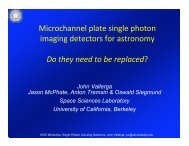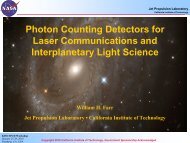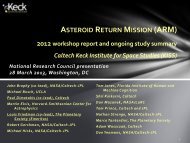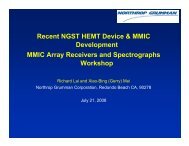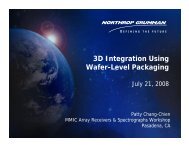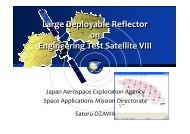Target NEO: Open Global Community NEO Workshop Report
Target NEO: Open Global Community NEO Workshop Report
Target NEO: Open Global Community NEO Workshop Report
Create successful ePaper yourself
Turn your PDF publications into a flip-book with our unique Google optimized e-Paper software.
DRAFT: RELEASED FOR PUBLIC COMMENTspace has become a critical issue. Although more than 7,800 <strong>NEO</strong>s are known as of March 2011,the numbers and physical characteristics of the <strong>NEO</strong>s in extremely Earth-like orbits, which tendto be the <strong>NEO</strong>s most accessible for human exploration, are uncertain because only a small fractionof the population has been discovered and tracked.The status of ongoing <strong>NEO</strong> observational survey programs was reviewed. These include groundbasedtelescopic surveys and a space-based telescopic search and characterization program. Thesession also presented the status of <strong>NEO</strong> database and archive facilities, as well as our presentunderstanding of the <strong>NEO</strong> population.2.1 <strong>NEO</strong> Monitoring and Publication of ResultsThe Minor Planet Center (MPC) at the Smithsonian Astrophysical Observatory (SAO) is grantedauthority by the International Astronomical Union (IAU) but is funded by the NASA Near EarthObject Observations Program. The MPC processes and publishes positional observations of SolarSystem objects from all observatories around the world. It maintains a Web-accessible orbitdatabase that includes asteroids, comets, outer Jovian satellites, Centaurs, and Trans-NeptunianObjects (TNOs). It receives daily observations of minor planets and releases daily updates of <strong>NEO</strong>observations. It also publishes rapid alerts of interesting <strong>NEO</strong> discoveries within hours of initialobservational reports. The MPC is prepared to process the data volume from next-generation <strong>NEO</strong>surveys.The <strong>NEO</strong> Program Office at the Jet Propulsion Laboratory (JPL) coordinates the <strong>NEO</strong> observationprogram for NASA. It provides a precision orbit determination service, maintains a Web-accessibledatabase on <strong>NEO</strong>s, and provides results of automated calculations of <strong>NEO</strong> close approaches toEarth. The <strong>NEO</strong> Program Office maintains a collision monitoring system, SENTRY, that examinesthe current asteroid and comet trajectories for objects that could impact Earth within 100 yearsor more, updates the orbits and uncertainties of these hazardous objects as new data arrive, andpublishes this information on the Web.2.2 The State of <strong>NEO</strong> Survey ActivitiesGround-based telescopic surveys, such as the Lincoln Near-Earth Asteroid Research (LINEAR)on the White Sands Missile Range near Socorro, New Mexico, have discovered the vast majorityof known <strong>NEO</strong>s. LINEAR demonstrated the application of technology for surveillance of Earthorbitingsatellites to <strong>NEO</strong> searches, using a pair of 1-m Ground-based Electro-Optical Deep SpaceSurveillance (GEODSS) telescopes with a limiting visual magnitude of about 20. LINEAR wasthe most successful search program from 1997 to 2004 and has discovered about 2,400 <strong>NEO</strong>s. TheCatalina Sky Survey (CSS) currently has a higher <strong>NEO</strong> discovery rate, using a system of threetelescopes at the Mt. Lemmon Observatory and the Catalina Observatory (both in Arizona) plusthe Siding Spring Observatory in Australia. The Mt. Lemmon telescope is the largest of these andachieves a limiting visual magnitude of 22. With its world-wide geographic distribution, CSS canusually accomplish same-night follow up on newly discovered objects. CSS has discovered about3,200 <strong>NEO</strong>s. An additional ground-based survey program, Panoramic Survey Telescope and RapidDRAFT: RELEASED FOR PUBLIC COMMENT 2




